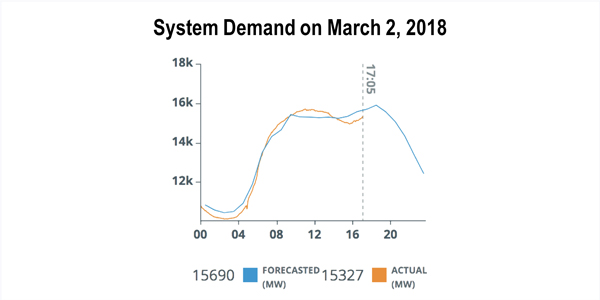By Michael Kuser
FERC on Wednesday accepted ISO-NE’s proposed new capacity bilateral transaction and a revised materiality threshold for determining whether a resource can satisfy its capacity supply obligation (CSO) (ER18-455).
The grid operator proposed the annual reconfiguration transaction (ART) to replace the capacity market’s existing bilateral contracting mechanism, the CSO bilateral. The RTO said the change was needed to accommodate its transition to marginal reliability impact-based demand curves (MRI), which are based on the expected improvement in reliability from adding incremental capacity.
The commission’s Feb. 28 order said that the ART will give resources looking to replace their CSO through a bilateral contract more flexibility. “The ART mechanism will accommodate even or uneven exchanges within the same zone or across constrained zone boundaries, even where exchanges previously were prohibited, while accounting for the actual net impact on reliability in a manner that does not disadvantage suppliers or consumers,” the commission said.
FERC also agreed to ISO-NE’s proposal to change how it determines when to submit demand bids in the third Annual Reconfiguration Auction (ARA) for resources that have a significant decrease in capacity. The RTO said its previous threshold — 20% of its CSO or 40 MW, whichever is lower — produced outcomes that focus on relatively small deficiencies and ignore relatively large deficiencies. For example, a 35-MW deficiency from a 100-MW resource would be subject to the RTO’s mandatory demand bid rule, while the same deficiency from a 200-MW resource would be exempt.
Under the new rules, the RTO will intervene when a resource’s capacity decreases by 10 MW, or 10% (but at least 2 MW), whichever is lower.
The commission dismissed FirstLight Power Resources’ request to eliminate the minimum 2-MW floor for the threshold. “We do not find any evidence that the proposed changes will result in undue discrimination among resources or compromise the integrity of the capacity markets, as FirstLight claims,” it said. The proposed thresholds “reasonably balance the impact on large and small resources, while reducing ISO-NE’s administrative burden.”
FERC also rejected a request from New England generators Exelon, CPV Towantic and NRG Power Marketing that the mandatory demand bid changes take effect in Forward Capacity Auction 9, rather than FCA 11.
Because it found the “proposal, including its implementation date, to be just and reasonable, we need not consider whether an alternative proposal is also just and reasonable,” the commission said.
There was no evidence that the new threshold will undermine the integrity of the capacity market, the commission said. “For all resources, regardless of the significant decrease threshold, the general obligations associated with having a CSO continue to apply.” The existing thresholds have not undermined the integrity of the capacity market or sent a signal that it is appropriate to intentionally overstate a resource’s capacity values, it said.
“We find it is reasonable to expect that the revised rules, which ISO-NE expects to affect a similar amount of capacity as the existing rules, likewise would not undermine the integrity of the market,” the commission said.





